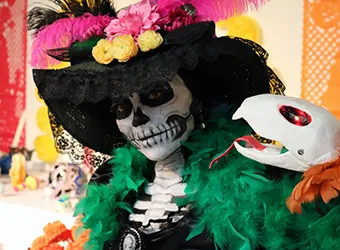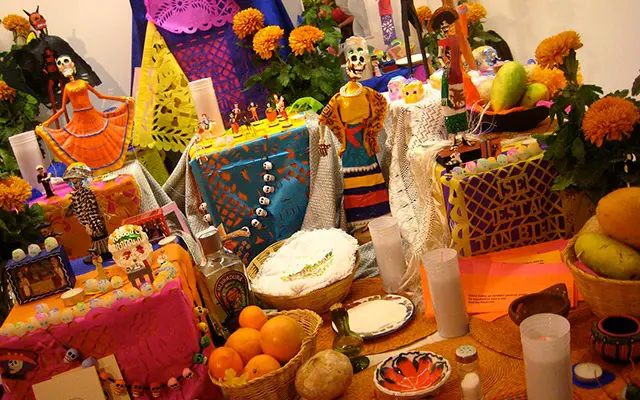Where to celebrate Day of the Dead in Mexico?
Visit some of the best «Day of the Dead» destinations in Mexico and explore the distinct feast celebrations of each area.

Oaxaca

Celebrating the Day of the Dead in Oaxaca is definitely a unique experience.
Being an important center of native Mexican culture the whole region provides endless opportunities to observe the feast on the most genuine and traditional way.
The historic center of Oaxaca is listed as a Human World Heritage by UNESCO and a number of over 500 smaller town and picturesque villages around it construct one of the areas with the richest cultural and traditional background in the country.
Given that it is a region with less "colonization influences" during the centuries, the followed customs are highly related to the Aztec and Mesoamerican past.
As in the whole country the celebration in Oaxaca lasts officially from the 31st of October until the 2nd of November, but the actual events and activities extend the festivity for more than a week. Among others, the Day of the Dead Markets attract many visitors who have the opportunity to observe, buy and taste all the items and foods that are placed on the altars and play a significant role at the feast. Parishes, schools, and other organizations take part in altar contests and their altars are parts of public exhibitions.
Another unique mortuary custom of this region is the construction of the sand tapestries. The tapestries depict religious images and typically is made in the house of a family which loses a member. During the festival, those tapestries can be found in squares and neighborhoods of Oaxaca.
Finally, a visitor of the city during that period will certainly have the opportunity to observe one of the "self-organized" parades that are taking place at the neighborhoods of the city. People in costumes pass by the streets and share the joyful feeling of the celebration to the whole community.
Yucatan

This region is the home of the ancient Maya civilization and the Day of the Dead is observed as Hanal Pixan (food of the souls).
The practices that are followed during the festivity in Yucatan peninsula are very similar to other parts of the country. Thus, street parades, altar decorations are among the highlights of the festival here as well.
The main festive dish of the area is the mucbipollo that is a chicken tamale wrapped in banana leaves and cooked underground.
Based on a local belief, people of the rural areas are used to tie red or black strings around the wrists of their children. These strings target to protect the younger from the spirits which even if they are not malicious, sometimes the play tricks to the children.
Michoacan (Lake Patzuaro)

One of the favorite destinations for those who wish to skip the major touristic spots and observe a genuine and unique celebration of the day of the dead is the Lake Patzucuaro.
The island of this lake is the meeting point of thousands of people who reach the small cemetery and honor the spirits for the whole night. According to the tradition, pilgrims from every town around the lake embark on boats which are decorated with candles and flowers and reach the small island in the dusk. The indigenous families (purepechas) decorate the gravesite and spend the whole night eating and drinking waiting for the souls of their beloved ones to arrive. This ritual process attracts many observers who try to avoid to miss this annual meeting of devoutness.
Mexico City

The last few years Mexico city started to host one of the most vivid and entertaining Day of the Dead celebrations in the country.
The highest contribution on this has the Hollywood James Bond film 007:Spectre that released in 2015 and included a skull procession in the central streets of the city. That inspired the local authorities which took the initiative to bring in life Day of the Dead parade in a great scale. So, from 2016 thousands of locals and tourists observe the Calavera Cartina and other figures to lead a huge parade that is expanded in the central streets of the city.
A colorful and festive mood dominates on each corner of the city during the festival. It is a habit for many locals to built altars and other decorations just outside their homes while in many neighborhoods people compete with each other for the best decoration.
Aguascalientes

Located approximately 200 kilometers north of Guadalajara, the city of Aguascalientes offers an extended celebration of the Day of the Dead.
The festival here lasts for almost a week. It starts already from the 28th of October and hosts the famous Festival de las Calaveras (Festival of the Skulls). Among the highlights of the celebration is the Great Calaveras parade which crosses the historic center of the city through the Madero Avenue. It is well-known for the numerous allegoric floats featuring plenty of themes and figures related to the Day of the Dead traditions.
Aguascalientes is the birthplace of the creator of La Calavera Catrina Jose Guadalupe Posada, and as expected his character dominates the festivity in the Grand Parade and the disguises of the locals in the events of the city. The visitor here can enjoy food markets, handicraft exhibitions and fairgrounds for the whole duration of the festival.
Chiapas

Chiapas is another region where the indigenous population dominates and as a result, the celebrations of the Day of the Dead are very vivid, colorful as well as close to the traditional meaning and practices.
Many argue that experiencing the Day of the Dead Festival in a rural area like Chiapas is similar to a trip to the past while it offers a unique opportunity to observe customs and manners which are directly related to the Aztec heritage of Mexico.
The cemeteries are becoming the center of the feast with beautiful decorations, vigils, and live music events. Many cities at this area have their own “indigenous administration” and they organize public events which highlight the distinctive traditions, rituals, and customs of the local population.



